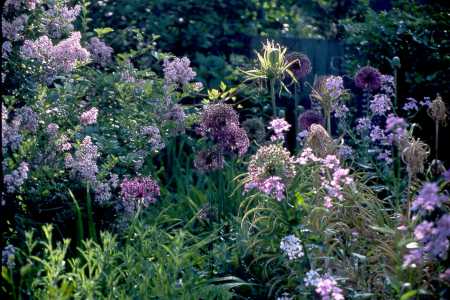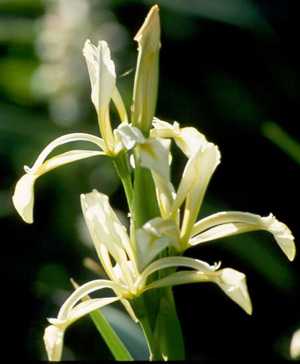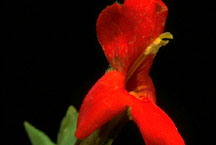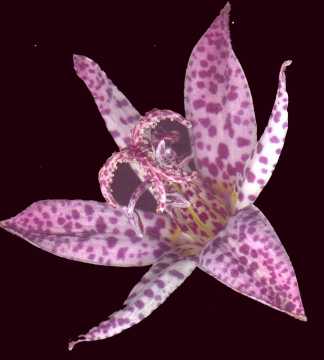My City Garden
By Clement Kent
April 20, 20001

Our garden in Toronto is now 9 years old. When we moved we selected our new house partly for its 200 foot long lot, which gives us a large back yard by downtown standards. Although neighboring trees and houses mean we have the usual number of shady spots, quite a bit of the garden gets close to full sun - a real luxury in this century old neighborhood. When you go on the garden tour June 3 you'll be a tourist in this garden - so here's your Michelin guide.

There wasn't much when we came here - a big old pear tree and a mockorange which we kept, and a diseased tea rose which we ripped out. All the rest was lawn. That was the next to go, all but a central area for dogs and kids. In went trees, shrubs, vines, perennials, and whatnot: apples, peaches, cherries, crabapples, magnolias grown from seed, a redbud, persian lilacs, kerria, spireas, cornus, caryopteris, forsythia, even a Parrotia donated to our neighbors' yard where it would make a screen for a view we didn't like.
David Austin roses came as a housewarming gift from friends Barry Parker and Michel Lefebvre, while climbing New Dawn (layered from the one on the porch of our old house) went in to climb the pear and magnolias. Clematis - many species and a few cultivars - were put along our long fence lines and next to shrubs and trees. A deck was built with supports overhead for wisteria which now flowers massively and provides welcome summer shade. The many half-hardy plants which live in pots in our greenhouse, (formerly the basement steps), spend the warm months on the deck.

Quantities of perennials - divisions from our old garden and new ones from seed - were mixed with lots and lots of bulbs. In memory of our year in the limestone mountains of southern France, a limy rock garden was built and populated with plants such as Gypsophila (baby's breath) which like lime.
As the years passed our trees grew and one border became ever more shady. More woodland plants, both natives and exotics, now grow in this 100 foot bed. The biggest show is in April and May but there's something in bloom until November.

In 1999 the pond and stream were started, and they are maturing nicely. If the
weather cooperates the bog plants may be in bloom for the garden tour - primulas,
monkeyflowers, Louisiana and native swamp irises, with a backdrop of siberian irises.
The hardy waterlilies probably won't be blooming yet but their mottled
leaves should be attractive, while our native bog lobelias, cardinalis and syphilitica, won't
will promise flower spikes for midsummer. Roses and clematis will
drape the archway on the far side of the pool while the stalks of the trumpet lilies
I started from seed 7 years ago will be rising towards their July bloom.

Each year brings something new. A "Graham Thomas" rose was added this spring as part of a dual homage to David Austin and the eponymous Mr. Thomas. A variety of Linarias I started from seed this winter should be gaudy in the rock garden while some of my other seedling experiments, such as the fragrant California native plant Madia elegans will be blooming for the first time. Will the Australian "Scarlet wisteria" flower in its pot? Will my Chalon hybrid pansies (growing in the basement since December) blossom well? Which of my Plant Fair purchases will have found a home and be showing off? You'll have to come and see for yourself....
Last year I much enjoyed buying a few of Barry Parker's seedling plants when I passed through his garden on the tour. I'll have a few of mine available to "tourists" this year, including a few oddities. As a special focus I'll have seedlings and divisions of both bog and water plants, including a few water lilies suitable for half barrels on a half-shaded deck or patio, and mosquito-eating fish that thrive in pond or barrel.
Copyright 2001 by Clement Kent, c l e m e n t @ g o d e l . n e t